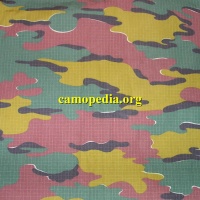Puzzle
Puzzle/Jigsaw
The term puzzle has been coined by collectors and historians to refer to a category of camouflage designs characterized by having shapes that resemble the pieces of a jigsaw puzzle. The term "jigsaw" may also refer to this class of camouflage designs (although it is generally used in reference to Belgian designs and their derivatives). Unlike most other families of camouflage, there is not any one particular pattern that can be classified as the root or origin of this particular branch of design. Rather, it appears several several smaller branches are all related to a central "theme," this being shapes that look like or remind us visually of jigsaw puzzle pieces. The most prominent of older puzzle patterns was developed by Belgium in the 1960s and continues to be worn by this nation today. However, other types of puzzle designs were developed independently in Yugoslavia, the Philippines, and elsewhere, and appear to have no connection to each other at all.
Belgian Jigsaw Camouflage Patterns
- The origin of the Belgian "jigsaw" camouflage design is unknown. Although the earliest Belgian camouflage patterns were influenced by British WW2 brushstroke designs, the jigsaw pattern seems to have been developed independently of other designs of that period. First introduced in 1956, the pattern has continued to exist in Belgian service in one incarnation or another into the present day. Belgian jigsaw camouflage has spawned a small but highly derivative subset of camouflage designs that were mostly worn in Africa.
- Produced by the Belgian firm Seyntex in 1980 for the Royal Dutch Marines, this is another jigsaw-derivative pattern.
- Produced by the Belgian firm Salik and the French firm K-way, this jigsaw camouflage design seems to have only been produced commercially as lightweight rain gear, although it has seen extensive use with many countries, including France, Argentina, and others.
Other Puzzle Camouflage Patterns
- Some of the early Philippine camouflage designs incorporated very puzzle-like shapes.
- An early Polish camouflage design of the 1970s (often called "petals") bears characteristic shapes that would qualify it to be classified amongst the "puzzle" patterns.
- Developed originally in Yugoslavia, a series of camouflage patterns have earned the nickname "puzzle" among many historians and collectors.












